Poultry and the manure blame game

Chickens raised for meat are referred to as broilers. The term 'broiler'”' was contrived decades ago, when the chickens were so small they could be broiled in an oven. The chicken is much larger today, and thus needs to be baked instead of broiled, but the term broiler' stuck. There are many different ways of braising broilers, but the most common method is to raise them in confined buildings, where large groups live uncaged, walking on bedding made from material such as sawdust or wood shavings. As broilers age, their excrement accumulates in the bedding, and the manure along with the bedding must eventually be removed and disposed of.
Figure 1—Broilers (chickens raised for meat) in a production facility

The mixture of bedding and excrement is usually referred to as litter, but I will call it manure. The manure must be disposed of in some way. Students might be surprised that some poultry litter is fed to cattle as a low-cost source of protein. In Oklahoma, most of the litter is applied to the land as fertilizer for crops, and the manner it has been applied has been a source of considerable controversy.
Most of the Oklahoma broiler farms are located in the far eastern portion of state. So are some of the state's most valued lakes and rivers, like the Illinois river and the Lake Eucha. In the last few decades the quality of these lakes and rivers has deteriorated, and many, including the State of Oklahoma and the City of Tulsa (OK), place much of the blame on the manure generated from broiler production.
Figure 2—Broiler production in the U.S.

If you were to meet a broiler farmer, you would probably assume that she owns not only the land and the buildings where the chickens are raised, but the chickens as well. However, for most broiler farmers this is not the case. It is true that most broiler farmers do own the buildings and land, but the birds are owned by a large broiler processing corporation like Tyson Foods. So is the broiler feed. The farmer is then paid based on her ability to care for the birds, but she is also given strict instructions on how the birds should be raised. In many ways, the broiler producer is more like an employee of a corporation than an independent farmer. While I can't compare their incomes today with those in the past, these contracts are not very profitable, as more than half of poultry farmers live below the federal poverty line.
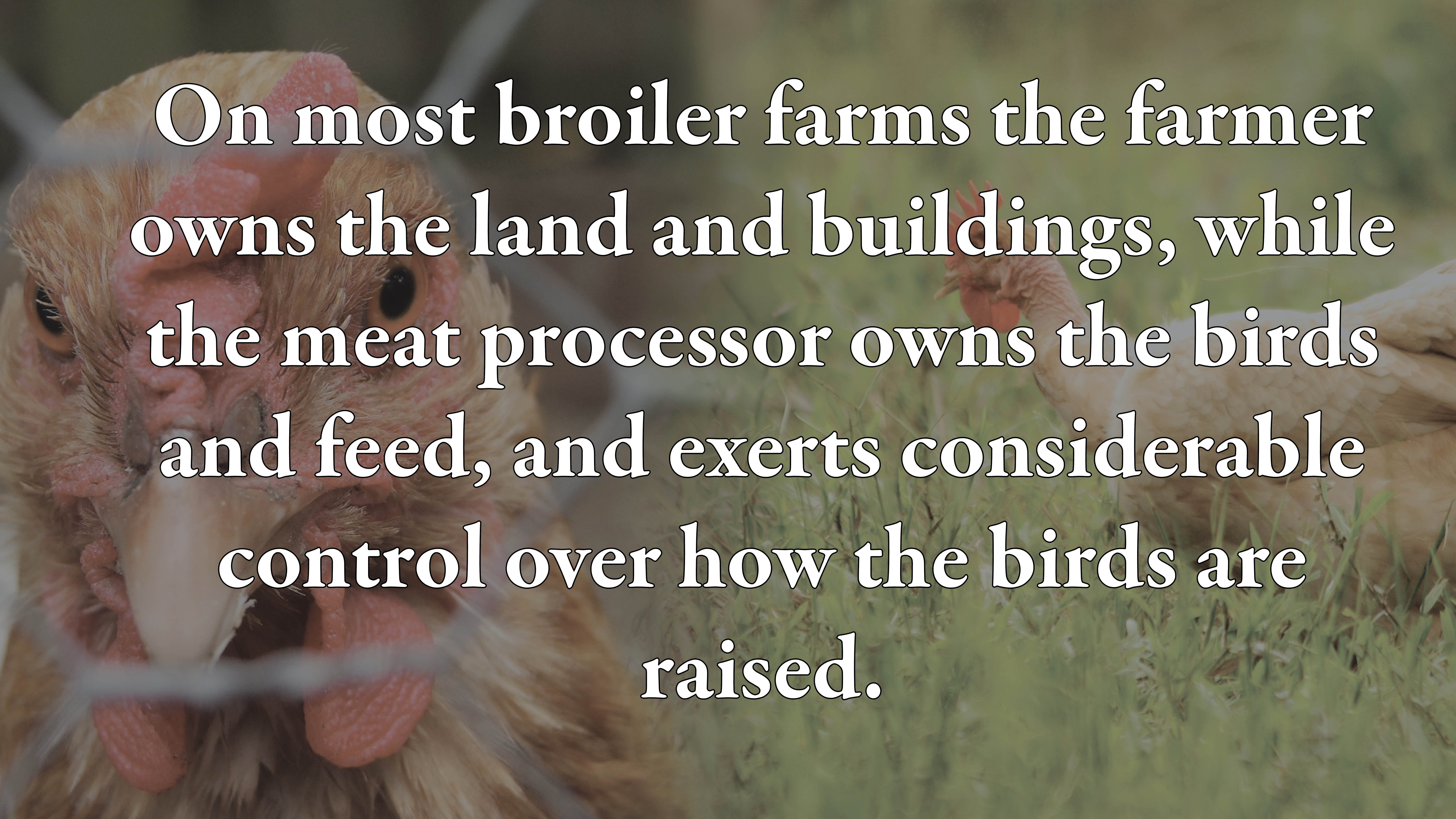
Because the 'farmer seems so different from what we are accustomed to, the farmers are often referred to as growers instead. However, I will retain the term 'farmer. This arrangement between the farmer and the corporation is dictated in official terms in contracts, referred to as production contracts. Most of the time these production contracts are confidential in that farmers cannot reveal the terms to the public or perhaps even one another.
One thing the farmer does own and is responsible for is the poultry manure. In most areas, this means that the farmer is responsible for finding cropland to apply the manure, and must do so following all government regulations. For some farmers this is a burden. The manure cannot be separated from the bedding, so when broiler manure is transported the bedding must be transported also. This makes the manure bulky and thus costly to transport. Adding to the difficulty is the fact that available cropland may be sparse compared to the amount of manure farms in a region generate.
Figure 3—Truck applying chicken manure to land
.png)
Poultry manure does have value for the nutrients it contains. Apply it to a field properly, and crop yields will rise. Why, then, are farmers not able to just sell the manure fertilizer to crop producers in more distant regions? The reason is that someone has to pay the transportation cost, and often, when you subtract the transportation cost from the value of the manure, you get a negative number. This means that applying the manure to cropland would then cost more than the value of its nutrients.
Due to the high cost of transporting broiler manure, farmers would prefer to apply large amounts to nearby cropland, rather than applying moderate amounts to distant cropland. If allowed to do this, as they have in the past, the nearby cropland receives more nutrients than the plants can consume. This is a problem because manure contains nutrients not just for animals and plants, but algae and bacteria. The manure nutrients that are not taken up by plants are washed away from the field. Some of these excess nutrients will fertilize natural ecosystems adjacent to the field, causing no pollution, but some of the excess nutrients will reach surface waters (ponds, lakes, streams, rivers, estuaries) and feed bacteria and algae in the water. If fed large amounts of these nutrients the bacteria and algae populations can explode and consume all the oxygen, thereby leading to a dead water where no oxygen-needing organism can live.
This aquatic death is referred to as eutrophication. It not only makes an ugly site, but interferes with the recreational value of the waters. If used as drinking water, municipalities may have to employ costly treatments before it can be delivered for human consumption.
Toledo, Ohio experienced this recently when phosphorus from farm runoff and sewage-treatment plants entered Lake Erie, causing such large algae blooms that citizens were temporarily asked not to drink the water from their faucets, but bottled water instead.
Figure 4 Eutrophication in the Potomac River (Washington, D.C.)
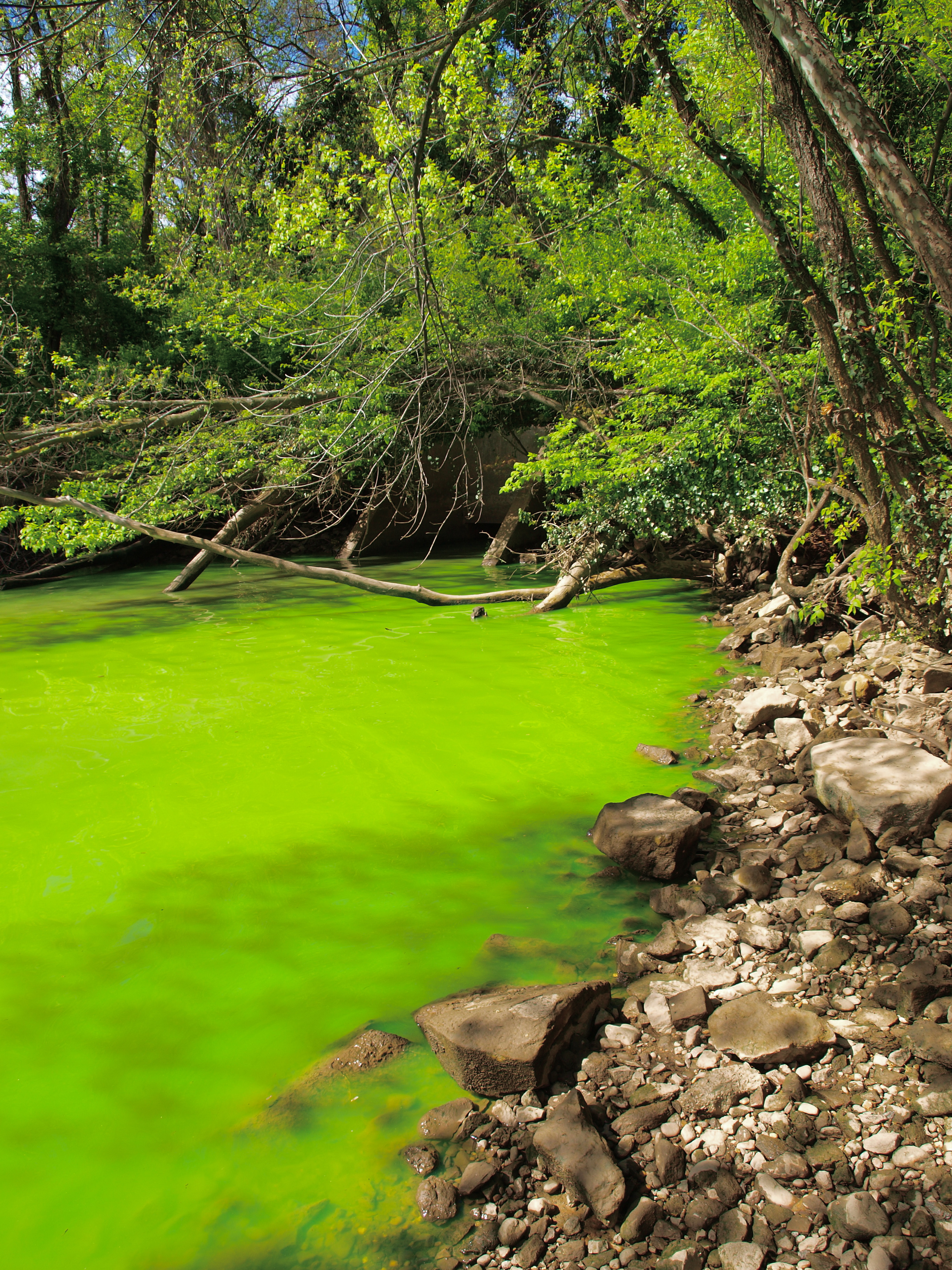
This has become a big problem in Oklahoma lakes and rivers. While it was not proven in court that the pollution stemmed from poultry manure, many, including the former State Oklahoma Attorney General Drew Edmondson, believed poultry manure to be a major contributor. In another court case, broiler corporations settled out of court, which might be viewed as an admittance of some responsibility for the water pollution. The State of Oklahoma takes the problem so seriously they have erected an entire center dedicated to reducing pollution caused by poultry manure.
Figure 5—Lake Eucha (OK) suffering from eutrophication

The phosphorus problem
To understand why manure is over-applied, it is necessary to discuss how farmers decide how much manure to apply to each acre. In previous decades, most water pollution stemmed from the nitrogen in manure, and so regulations required that if an acre of crops could only consume 100 lbs of nitrogen per acre, then manure had to be applied at a rate where the nitrogen content of the manure did not exceed 100 lbs per acre (regardless of how much phosphorus was applied along with it).

This led to excess phosphorus, though, because the ratio of phosphorus to nitrogen in manure is greater than the ratio consumed by crops. For instance, broiler manure contains about 0.65 lbs of phosphorus (in the form of P2O5) for every lb of nitrogen, whereas crops need only 0.05 to 0.4 lbs of P2O5 for every lb. of nitrogen.(L1)
As an analogy, I try and feed my daughter Maggie well-balanced meals, with the same proportions of fruits, grains, vegetables, protein, and dairy as the USDA recommends in its myplate.gov system. This well-balanced meal consists of 30% vegetables (of total calories, I presume). She is good about eating fruits, grains, protein, and dairy, but not so crazy about vegetables. Much of the vegetables I feed her are left on the plate. I am feeding her a meal with a higher ratio of vegetables than she will consume. Likewise, farmers were applying manure with a higher ratio of phosphorus than plants would consume. The vegetables left on my daughter's plate get thrown away. The phosphorus left on the field washes away, some of it entering surface waters.
Figure 6—Feeding my daughter, Maggie
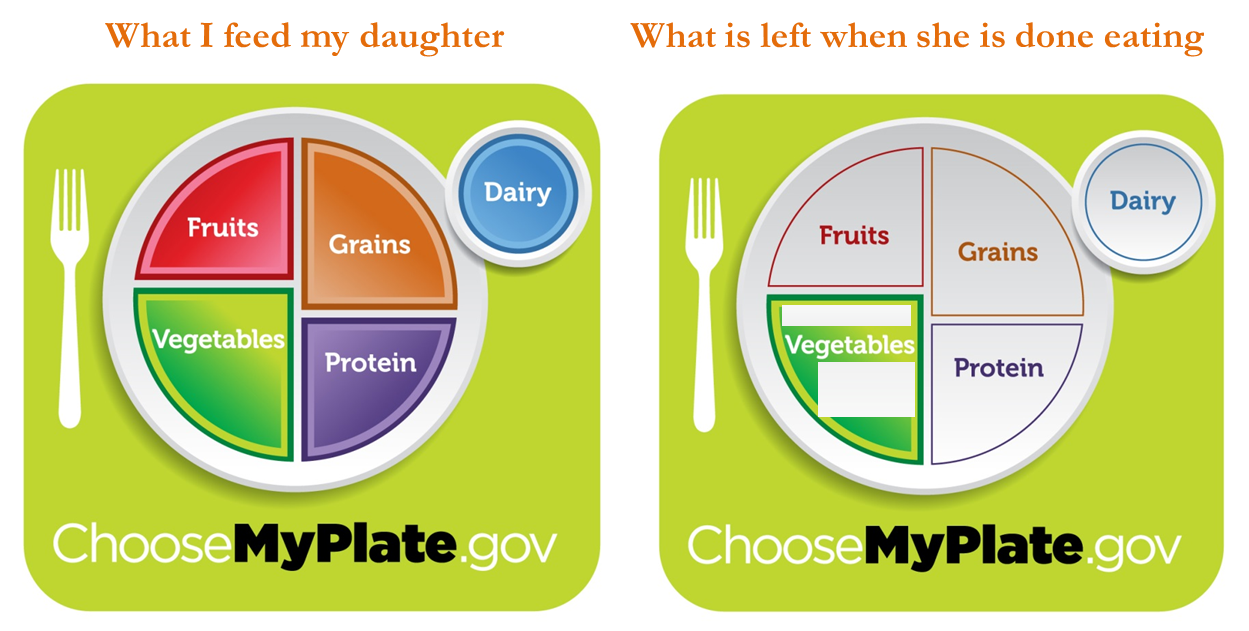
If I wanted to reduce the amount of food I discard, I would then need to feed my daughter less vegetables. If farmers wanted to reduce excess phosphorus, they would then apply less manure per acre, because you can't simply remove phosphorus from the manure. The problem is that this means farmers will then need more acres to apply their manure, and thus will have to truck manure greater distances. As the map below shows, large amounts of phosphorus are being generated in eastern Oklahoma, where broilers are raised, but most of the demand for phosphorus is located in the larger crop-producing regions of western Oklahoma. Ideally, the state could just ship phosphorus west, but as mentioned previously, doing so is expensive.
Figure 7—Supply and demand for phosphorus fertilizer
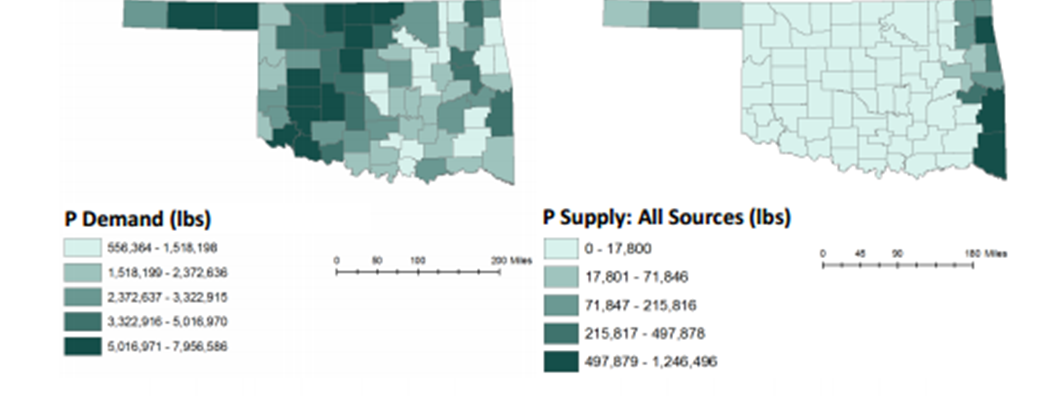
The chicken manure blame-game
Phosphorus runoff can come from many sources other than chicken manure. Chemical fertilizers and wastewater treatment plant emissions are two examples. Most scientists seem to believe the phosphorus entering surface waters in Oklahoma is mainly from broiler farms, as that is the opinion that the former Oklahoma Attorney General, Drew Edmondson, adopted. Assuming broiler manure is the major culprit, who is responsible for doing something to correct the problem? That is, who should pay the added expense of hauling poultry manure to more distant locations?
The responsibility for disposing of the manure legally belongs to the farmers, so if we abide by the terms of the production contracts that farmers signed, then farmers must pay this extra expense. It is hard for citizens to impose a burden on individual farmers, though, when they can blame the big corporations like Tyson Foods who owns the chickens. The Oklahoma Attorney General attempted to place the blame on the corporations by taking them to court, but the court ruled against them.

If you ask me who is to blame, I say there is enough blame to go around for everyone. Farmers signed contracts saying they were responsible for the manure, but at the same time the corporations probably knew much better than farmers what would happen when chicken production expanded in areas where little crop production takes place. It is likely that when negotiating contracts, the corporations insisted the farmer be responsible for the manure, so that, if water pollution problems did occur, it would be hard to blame the corporation for it (that is indeed how it turned out).
Yet even university scientists like myself deserve some blame. This wasn't the first time phosphorus had polluted waters, and we should have thought more about preventing pollution rather than reacting to it. Environmental scientists and economists are supposed to think about how industry activity can affect the environment, and in hindsight, the pollution that occurred shouldn't have caught us by surprise. Similar remarks can be said about various state government agencies.
A solution in sight
The City of Tulsa also took broiler companies to court, which was settled out of court in 2003. The settlement forced poultry producers to cease applying manure until more responsible methods of handling the waste were developed. What ultimately developed was a phosphorus index system for determining how much manure should be applied to each acre. This index took into account the phosphorus in the soil; the crop planted and how it is harvested; how and when the manure is applied; and various aspects of the field such as its slope, flooding frequency, and type of soil.
This index should improve water quality in eastern Oklahoma, as it requires cropland to receive only about one-third of the manure per acre it received prior to the 2003 settlement. Fields more likely to experience flash floods and soil erosion must apply less manure. This leads to less excess phosphorus, and presumably, less water pollution.
(Note: although the phosphorus index was being formed in the few years prior to the 2003 settlement, it was still being refined and its use by farmers was not enforced with vigor.)
Although we (we meaning the farmers, corporations, environmental groups, state agencies, and university researchers) should have prevented the problem from ever occurring, our reaction seems effective, and I am optimistic that the waters will improve. The phosphorus index does force broiler farmers to ship their manure to more distant locations, thus placing responsibility for its disposal on the farmer, but the state helped by funding educational programs encouraging crop producers to calculate the nutrient value of manure. These programs also helped create a market for poultry manure, which initially subsidized the transport of manure. Today the market works fine without subsidies. Both programs made it easier for broiler farmers to find an outlet for their manure, and since these programs are partially funded by taxpayers, all of Oklahoma is indeed shouldering some of the responsibility.
Although the farmer is legally responsible for disposing of the manure, the lawsuits impelled the corporations to become more involved in manure management. In some cases the corporations agreed to haul away the farmers' manure for free, where they would then sell it to crop producers outside the watershed. How often this occurs, and how often they lose money doing this, is unknown.
So it seems that all parties are doing something to improve surface waters. Fortunately, the programs and regulations seem to be working, as water quality in eastern Oklahoma is improving.
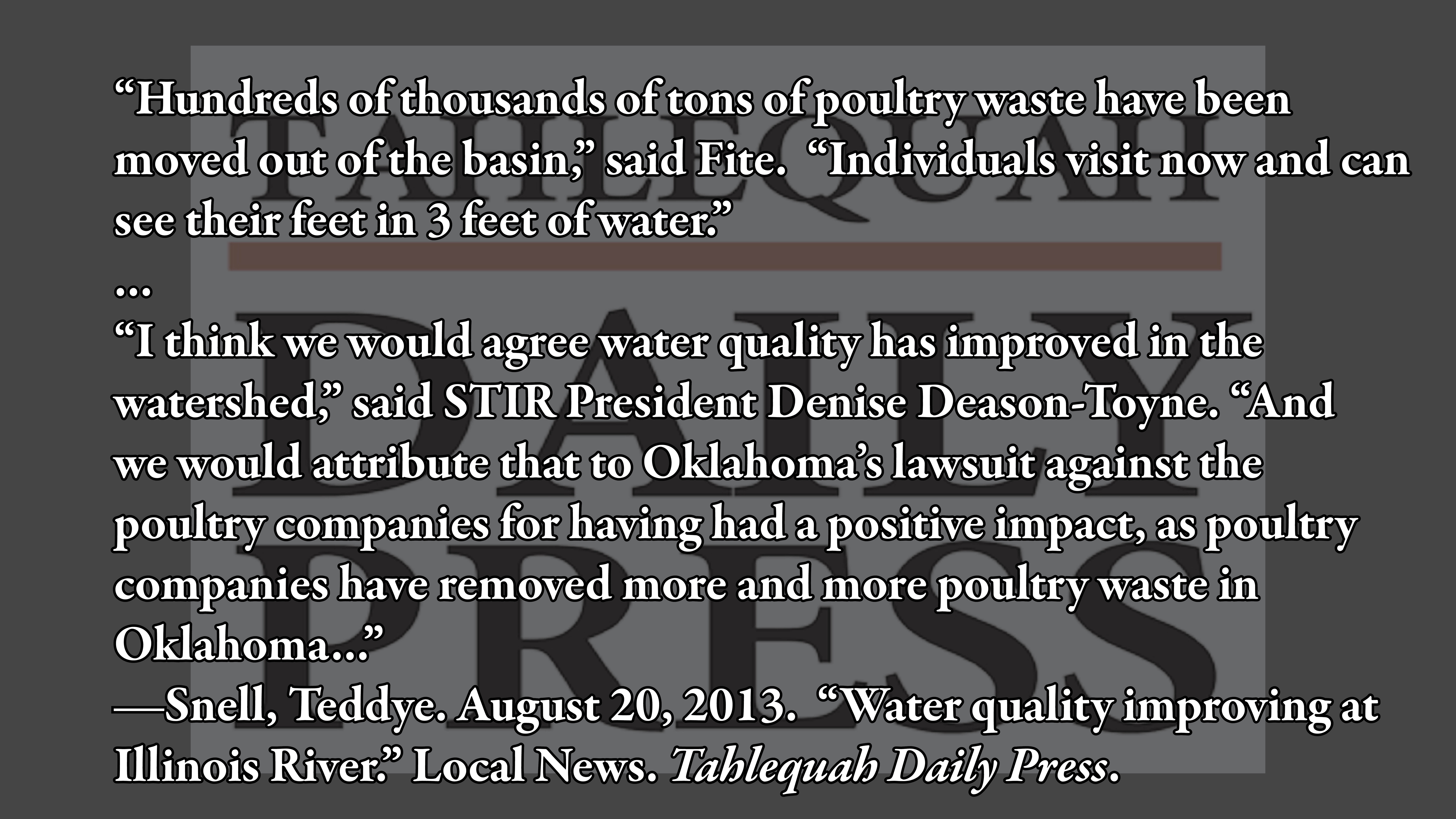
A world problem
This lecture focuses on a water problem in eastern Oklahoma, but the problem is one of a global scale. Certainly the whole U.S. is experiencing water quality problems. Of our lakes, rivers, and estuaries, 64%, 44%, and 30% are impaired. Not all is attributable to agriculture. Water can be impaired also by lawn fertilizers and human sewage treatment. However, I believe these waters will not be restored without changes in how we raise crops and animals.
Figure 8—The Gulf of Mexico watershed
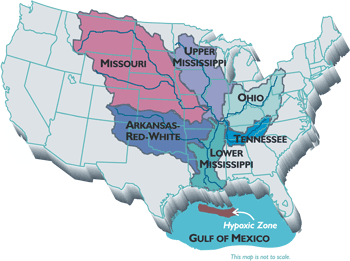
The most recognized area of water pollution is the “dead zone” in the Gulf of Mexico, where nitrogen and phosphorus from sources as far south as Louisiana and as far north as Montana are carried to the gulf, exhausting all the aquatic oxygen from 3,100 square miles of water.
Figure 9—A 3,100 square mile “dead zone” in the Gulf of Mexico.
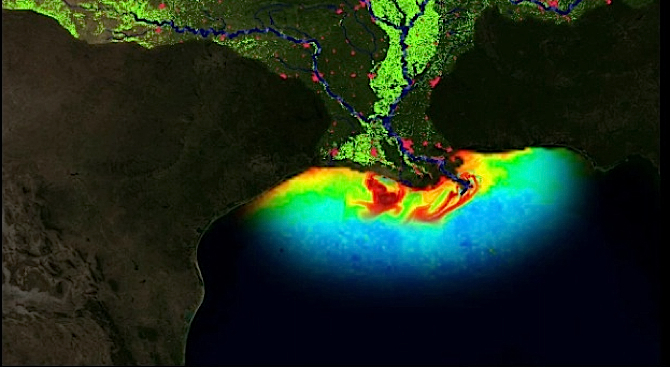
As Chinas agricultural productivity has exploded due to its use of chemical fertilizers, it has reached a point where more than 50% of its lakes are impaired. This illustrates that eutrophication can result from both manure and chemical fertilizers, so policies aimed at restoring waters must address both. Manure alone should not be the only agricultural source blamed.
Water quality is a worldwide challenge and must be confronted everywhere, in many different forms. Even holy springs' in Austria are contaminated,(F1) so even the Christian God could use our help!
Figures
(1) Personal photo.
(2) Accessed from 2007 Census of Agriculture on July 19, 2014 at www.agcensus.usda.gov/Publications/2007/Online_Highlights/Ag_Atlas_Maps/Livestock_and_Animals/Livestock,_Poultry_and_Other_Animals/07-M161.php.
(3) Picture made available by CASNR at Oklahoma State University.
(4) By Sasha Trubetskoy (Own work) [CC-BY-SA-3.0 (creativecommons.org/licenses/by-sa/3.0)], via Wikimedia Commons
(5) Picture provided by anonymous employee of the state of Oklahoma.
(6) Available at USDA at www.choosemyplate.gov/print-materials-ordering/graphic-resources.html.
(7) Made available by Dr. Jeffrey Vitale, Associate Professor, Department of Agricultural Economics, Oklahoma State University. 2014.
(8) From EPA and Wikimedia Commons at en.wikipedia.org/wiki/File:Gulf-mexico-watershed.gif.
(9) Source: NOAA Environmental Visualization Laboratory.
References
(A1) American Heart Association. March 19, 2014. Vegetarian Diets [web article]. Accessed July 22, 2014 at http://www.heart.org/HEARTORG/GettingHealthy/NutritionCenter/Vegetarian-Diets_UCM_306032_Article.jsp.
(B1) Balaker, Ted. November 4, 2014. Town Bans Body Odor; Cops Decide Who Smells Illegal. ReasonTV. Accessed November 8, 2014 at http://reason.com/reasontv/2014/11/04/nanny-oct-2014.
(C1) Charles, Dan. May 2013. Our Fertilized World. National Geographic. 94-111.
(C2) Chesapeake Bay Program. Chesapeake Bay TMDL [web article]. Accessed July 22, 2014 at https://www.chesapeakebay.net/about/programs/tmdl.
(D1) Daniel, Jay and K. C. Olsen. October 2005.Feeding Poultry Litter to Beef Cattle. Agricultural MU Guide. MU Extension. University of Missouri-Columbia. G2077.
(D2) DeLaune, P. B., B. E. Haggard, T. C. Daniel, I. Chaubey, and M. J. Cochran. 2006. The Eucha/Spavinaw phosphorus index: A court mandated index for litter management. Journal of Soil and Water Conservation. (61)2.
(D3) Diep, Francie. November 2011. Cholesterol Conundrum. Scientific American. Pages 32-33.
(D4) Doyle, M. W., L. A. Patterson, Y. Chen, K. E. Schnier, and A. J. Yates. 2014. Optimizing the scale of markets for water quality trading. Water Resources Research. 50:72317244. Doi:10.1002/2014WR015395.
(E1) United States Environmental Protection Agency. 2009. The National Water Quality Inventory: Report to Congress for the 2004 Reporting Cycle—A Profile. USEPA Office of Water. EPA 841-F-08-003.
(E2) Environmental Protection Agency. Chesapeake Bay TMDL [web article]. Accessed July 22, 2014 at http://www.epa.gov/chesapeakebaytmdl/.
(F1) Fields, Liz. September 14, 2013. Holy Water May Be Harmful To Your Health, Study Finds. ABC News. Accessed September 17, 2013 at http://abcnews.go.com/Health/study-holy-water-harmful-health/story?id=20257722.
(F2) Food & Water Watch. Pollution Trading and the Chesapeake Bay Total Maximum Daily Load [web article]. Accessed February 25, 2014 at https://www.foodandwaterwatch.org/common-resources/pollution-trading/.
(G1) Gallo, Andrea. August 3, 2014. Algae Blooms Making Toledo Water Undrinkable Are Thriving. The Wall Street Journal. Accessed August 6, 2014 at http://online.wsj.com/articles/algae-blooms-making-toledo-water-undrinkable-are-thriving-1407107871.
(K1) Kounang, Nadia. June 9, 2014. —Are butter, cheese and meat that bad?— CNN health. Accessed July 22, 2014 at http://www.cnn.com/2014/06/06/health/saturated-fat-debate/.
(L1) Lory, John A. April 1999. Managing Manure Phosphorus to Protect Water Quality. University of Missouri Extension. Accessed April 24, 2014 at http://extension.missouri.edu/p/G9182.
(N1) Norwood, F. Bailey, Michelle S. Calvo, Sarah Lancaster, and Pascal A. Oltenacu. 2014. Agricultural and Food Controversies: What Everyone Needs to Know Oxford University Press: NY, NY.
(N2) Norwood, F. Bailey and Jayson L. Lusk. 2011. Compassion, by the Pound. Oxford University Press: NY, NY.
(O1) Oklahoma State University. OklahomaPoultry Waste Management Regulations [brochure]. Poultry Waste Management Center. Accessed February 25, 2014 at http://poultrywaste.okstate.edu/oklahoma-regulations/files/Regulations%20Brochure%20020514.pdf.
(P1) Perez, Michelle. April 17, 2013. Can Nutrient Trading Shrink the Gulf of Mexico's Dead Zone?. World Resources Institute. Accessed Feburary 25, 2014 at http://www.wri.org/blog/can-nutrient-trading-shrink-gulf-mexicos-dead-zone.
(P2) Personal correspondence with Josh Payne, Area Animal Waste Management Specialist at Oklahoma State University. July 18, 2014.
(S1) Scott, J. Thad, Brian E. Haggard, Andrew N. Sharpley, and J. Joshua Romels. 2011. Change Point Analysis of Phosphorus Trends in the Illinois River (Oklahoma) Demonstrates the Effects of Watershed Management. Journal of Environmental Quality. 40:1249-1256.
(T1) Texas A&M. June 27, 2013. Large Dead Zone Forming In The Gulf [web article]. Newswise. Accessed June 28, 2013 at http://www.newswise.com/articles/texas-a-m-large-dead-zone-forming-in-the-gulf.
(T2) Taylor, Timothy. Obesity—Who Bears the Costs? Unexpected Economics. Tyhe Great Courses. The Teaching Company.
(U1) United States Geological Survey. January 9, 2013. Sources of nutrients delivered to the Gulf of Mexico [webpage]. Accessed May 28, 2013 at http://water.usgs.gov/nawqa/sparrow/gulf_findings/primary_sources.html.
(U2) United States Geological Service. February 24, 2014. Sources of nutrients delivered to the Gulf of Mexico [webpage]. Accessed February 25, 2014 at http://water.usgs.gov/nawqa/sparrow/gulf_findings/primary_sources.html.
(W1) Wall, Frans de. September 2014. ONE FOR ALL. Scientific American.
(Z1) Zublena, J. P., J. C. Barker, and T. A. Carter. 1997. SoilFacts: Poultry Manure as a Fertilizer Source. North Carolina Cooperative Extension Services. AG-439-5.